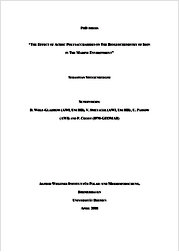The effect of acidic polysaccharides on the biogeochemistry of iron in the marine environment
Steigenberger, Sebastian
Univ. Bremen
Monography
Verlagsversion
Englisch
Steigenberger, Sebastian, 2008: The effect of acidic polysaccharides on the biogeochemistry of iron in the marine environment. Univ. Bremen, 106 S., DOI: 10.23689/FIDGEO-180.
 |
View/
|
In the early 1990`s the first IPCC report stated the effect of anthropogenic CO2 emissions on global warming and John Martin`s Iron Hypothesis (Martin and J.H 1990), relating atmospheric dust deposition, a major source of iron to the surface ocean, to the CO2 concentration in the atmosphere and the last ice age, culminating in the well known sentence Give me (half) a tanker of iron and I’ll give you a new ice age!. Since then, several large-scale in situ Fe fertilisation experiments revealed that in large areas of the ocean, the so called high nutrient low chlorophyll (HNLC) areas, phytoplankton growth is partly limited by depleted Fe conditions (Geider et al. 1994; De Baar and Boyed 2000; Boyd et al. 2007). The ocean receives Fe from upwelling, riverine input, melting icebergs, atmospheric dust input, input from anoxic sediments, hydrothermal vents and direct recycling by organisms(Tovar-Sanchez et al. 2007). However, in HNLC regions the Fe input to surface waters is very low resulting in Fe limitation of phytoplankton growth. Fe is an important nutrient for marine phytoplankton (Geider et al. 1994; Falkowski et al. 1998; Morel and Price 2003), being essential in metabolic reactions like the photosynthetic electron transport and the assimilation of nitrogen. It is also required for the synthesis of chlorophyll (Martin et al. 1988; Maldonado et al. 1999) as well as for the functioning of the enzyme superoxide dismutase which inhibits the breakdown of chlorophyll by superoxide radicals (Coale 1991)...

